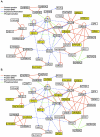Association analysis of 94 candidate genes and schizophrenia-related endophenotypes
- PMID: 22253750
- PMCID: PMC3258248
- DOI: 10.1371/journal.pone.0029630
Association analysis of 94 candidate genes and schizophrenia-related endophenotypes
Abstract
While it is clear that schizophrenia is highly heritable, the genetic basis of this heritability is complex. Human genetic, brain imaging, and model organism studies have met with only modest gains. A complementary research tactic is to evaluate the genetic substrates of quantitative endophenotypes with demonstrated deficits in schizophrenia patients. We used an Illumina custom 1,536-SNP array to interrogate 94 functionally relevant candidate genes for schizophrenia and evaluate association with both the qualitative diagnosis of schizophrenia and quantitative endophenotypes for schizophrenia. Subjects included 219 schizophrenia patients and normal comparison subjects of European ancestry and 76 schizophrenia patients and normal comparison subjects of African ancestry, all ascertained by the UCSD Schizophrenia Research Program. Six neurophysiological and neurocognitive endophenotype test paradigms were assessed: prepulse inhibition (PPI), P50 suppression, the antisaccade oculomotor task, the Letter-Number Span Test, the California Verbal Learning Test-II, and the Wisconsin Card Sorting Test-64 Card Version. These endophenotype test paradigms yielded six primary endophenotypes with prior evidence of heritability and demonstrated schizophrenia-related impairments, as well as eight secondary measures investigated as candidate endophenotypes. Schizophrenia patients showed significant deficits on ten of the endophenotypic measures, replicating prior studies and facilitating genetic analyses of these phenotypes. A total of 38 genes were found to be associated with at least one endophenotypic measure or schizophrenia with an empirical p-value<0.01. Many of these genes have been shown to interact on a molecular level, and eleven genes displayed evidence for pleiotropy, revealing associations with three or more endophenotypic measures. Among these genes were ERBB4 and NRG1, providing further support for a role of these genes in schizophrenia susceptibility. The observation of extensive pleiotropy for some genes and singular associations for others in our data may suggest both converging and independent genetic (and neural) pathways mediating schizophrenia risk and pathogenesis.
Conflict of interest statement
Figures




References
-
- Harrison PJ, Weinberger DR. Schizophrenia genes, gene expression, and neuropathology: on the matter of their convergence. Mol Psychiatry. 2005;10:40–68; image 45. - PubMed
-
- Gogos JA, Gerber DJ. Schizophrenia susceptibility genes: emergence of positional candidates and future directions. Trends Pharmacol Sci. 2006;27:226–233. - PubMed
Publication types
MeSH terms
Grants and funding
LinkOut - more resources
Full Text Sources
Medical
Research Materials
Miscellaneous

